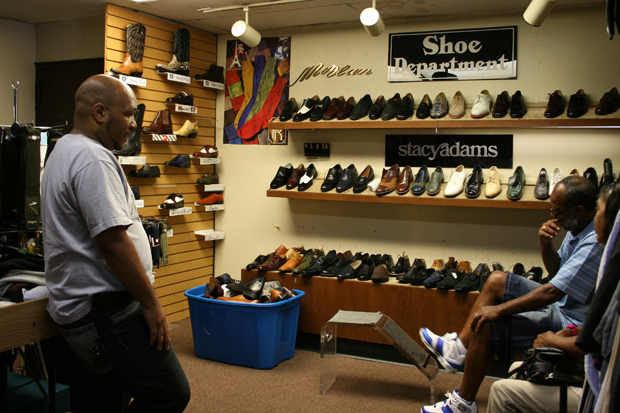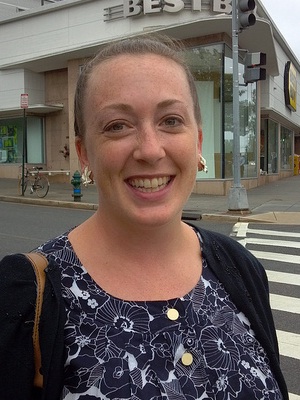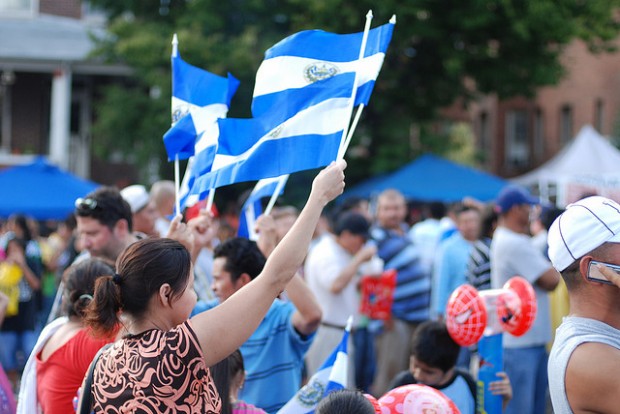Elahe Izadi / DCentric permalink
A sign on the front of George's Place reminds passersby how long it's been on the corridor.
A sign on the front of George's Place reminds passersby how long it's been on the corridor.
An employee sorts through items at George's Place. Owner George Butler says he's known for his selection of hats.
George Butler speaks with longtime customers about his impending closure.

A customer tries on shoes, hoping to take advantage of George's Place's going out of business sale.
George Butler is closing shop after nearly five decades. His men’s clothing store, George’s Place Ltd., is an H Street NE institution, one of the longest-running businesses on a corridor now synonymous with gentrification. But the recession, online competition and H Street streetcar construction led him to call it quits.
The 73-year-old managed clothing stores on the street in the 1950s before opening his store in 1968.
“I saw a future in H Street and my being in the neighborhood, I knew a lot of my customers,” he said while sitting in the back of his store on a recent afternoon. Hats and shoes lined the walls, along with 50 percent off signs.
Through it all, he’s had a front row seat to all the ups and downs of the corridor: from the heyday when it was “it was like Connecticut Avenue, like downtown,” to the 1968 riots. “I’m a vet, and I saw things I never saw in the war,” he recalled of the riots. “The street was unreal. Fires were everywhere. It was just burning down.”
The riots marked the commercial decline of the street, beginning decades of empty storefronts. “People left and never came back,” Butler said.
Poverty rates have reached their highest levels since 1993, with 1 in 6 Americans living in poverty in 2010, according to new census data released today. But not all groups have been affected equally.
Here’s what we’ve gleaned from the latest U.S. Census Bureau data dump, which includes information on the racial groups most likely to live in poverty, be without insurance or see drops in household income:
Who had the lowest poverty rate? Whites.
White people had the lowest poverty rate in 2010, at 9.9 percent. The percentage of whites living in poverty didn’t change much between 2009 and 2010, but household income did drop slightly.
Which group is hit hardest by poverty? African Americans.
We know the black middle class was particularly hit hard by the recession, but it’s not just the middle class that’s feeling disproportionate effects. More than a quarter of African Americans live in poverty, and the rate is rising faster than that of any other group.
Which group saw the biggest increase in the uninsured? Asians.
The percentage of Asians without health insurance increased to 18.1 percent, while it remained relatively stable for whites, blacks and Hispanics. However, Hispanics are still the most likely to be without insurance; nearly 1 in 3 don’t have coverage.
Are naturalized citizens less likely to live in poverty? Yes.
The poverty rate for immigrants who have become U.S. citizens is 11.3 percent. But that rate is more than double for the foreign-born who haven’t become citizens.
Who has the largest household income? Asians.
Households headed by an Asian had the largest median income in 2010, at $64,308, which is more than double the amount for African Americans. The median household income for whites was $54,620 in 2010. Measuring median income gives a more accurate picture of the state of a particular community because it controls for the very poor and the very rich — so people like Oprah and Bill Gates can’t skew the picture.
After the Sept. 11 terrorist attacks, there was a feeling that life in America had changed. Ten years later, we asked D.C. residents if they felt it had. For many in D.C., the attacks were more than a national event; They took place in our own backyard.
Officer Lonnie Moses, Jr., 46, patrols Ward 7, Southeast: "I had a friend whose daughter was on one of the planes. When I talk to him and see his face, I see how sad he is, and that affects me," he said. He thinks about his friends who work downtown for Capitol Police. "Being downtown makes me feel nervous sometimes because if something were to happen, I'd think it'd happen there. A lot of things have changed."

Kourtnii Brown, 31, LeDroit Park, Northwest: “My life hasn’t really changed; I didn’t know anyone connected to it. Obviously, security at airports blows now. I’m a germaphobe and I’ll be in sandals, they can see there’s no gun in my shoe but I still have to take them off. The racist aspect of it really gets to me. I have lots of Arab-American friends. They grew up here, went to high school here and I see how they are treated by certain people…and I don’t see the world like those people do. We’re all in it together. Diversity should be the best part of this country, but the legacy of that day is how it’s breaking us apart.”
How has your life changed?
Pull your pants up, was the advice given to a young man asking about job prospects during last month’s National Night Out event led by D.C. Council member Yvette Alexander and D.C. Fire Chief Kenneth Ellerbee, according to The Root DC.
The adults offered one place to start: pull up your pants.
“Oh, you’ve got Ralph Lauren,” Alexander told one of the young men. “I guess you want to show that off.”
What would happen, she asked, if they dressed like that and a nice, white lady walked by. “Do you think she might cross the street?” Alexander said.
One reader, MSTanya, took issue with Alexander’s attempt to illustrate her point:
Why did it have to be a “nice white lady” who walked by. Aren’t there any nice African American ladies who could have been used as an example? Yes, there definitely are, but as per the norm, it’s always a white person being looked at as nice…
We’re still waiting to hear back from the Council member’s office regarding her remarks.
According to “Anthropology off the Shelf,” low-slung pants are a symbol of incarceration. The book notes that “sagging as a style was adopted from prison culture, where belts are prohibited and ill-fitting prison garb is the norm.”

Cameron Nordholm / Flickr
A woman waves the Salvadoran flag during Fiesta DC in Mount Pleasant, one of D.C.'s longtime Latino centers.
Columbia Heights and Mount Pleasant, traditionally the center of the D.C.’s Latino community, are much different places now than they were 20 years ago. Big box stores sit upon formerly vacant lots. Pupuserias now have vegan cafes as neighbors. House values have exploded. Ward 1, where these neighborhoods are located, has lost more than 2,000 Latinos over the past decade.
Travel a few blocks south and you see a similar transformation. The U Street area, formerly “Black Broadway,” was 77 percent black; it’s now only 15 percent black. Many longtime residents who had bought homes at modest prices have sold them for large sums. Others were priced out by rising rents. Luxury high-rise condo buildings have sprouted up.
But while the number of African Americans throughout D.C. is declining — by 11 percent over the past decade –the number of Latinos actually increased, by about 21 percent. This growth happened despite the fact that rapidly increasing housing prices have particularly affected longtime Latino neighborhoods, according to the District’s 2009 State of Latinos report.
So why is D.C.’s Latino community growing while it’s black community shrinks?
“Stop Picking on the Black Middle Class; It didn’t abandon urban communities, despite what some say,” is the headline of Natalie Hopkinson’s article in The Root.
The piece references a recent Washington City Paper article, which asked “As parents in places like Capitol Hill embrace neighborhood schools, has D.C.’s black middle class given up on them?” Hopkinson answers, “If I were looking for a culprit in a racial group, the black middle class is the very last place that I’d be sniffing around.”
Hopkinson also describes her attempt to stop her next-door neighbor from selling crack. Confronting the man and shaming his customers didn’t work, so she called 311 and spoke to a black city employee who suggested that she do what the “white folks” did. Hopkinson wasn’t interested in that advice:
I was too furious to hear the rest. What in the Tiger Mom hell did my being white, black or purple have to do with the fact that this man was selling crack? “Just get someone over here!” I barked, and hung up the phone. Still, crickets.
Sadly, this attitude is par for the course in D.C. When you’re white — maybe especially in a very black city like Washington, D.C. — people pay attention. Some of it is the sheer novelty of whites living in previously all-black neighborhoods. Some of it is historical, and the socioeconomic position of whites in relation to blacks.
Whatever the reasons, as the city continues to gentrify, getting whiter and richer, progress is credited to white folks. It’s as if they deserve gold stars for consenting to live among the Negroes and cleaning up the Negro mess. Never mind the complicated cocktail of race, class and history that has shaped the city’s fortunes over the years. If you’re black, well … just try to be more like white people!
In the original City Paper feature, Jonetta Rose Barras wrote:
Continue reading

Stephen Chernin / Getty Images
A young man inserts the Rapid HIV test swab into its tube.
The HIV infection rate for young black men who have sex with men is growing at an “alarming” rate.
That’s according to a report released this month by the Centers For Disease Control and Prevention. The CDC studied HIV infection rates from 2006 to 2009, and found that the rate increased by 48 percent for 13 to 29 year-old black men who have sex with men. Meanwhile, infection rates have remained relatively stable for all other groups.
Healthcare providers and organizers in D.C., where 3 percent of the population has HIV/AIDS, are seeing the trend. Justin Goforth is the director of community health at Whitman-Walker Health, a center offering medical, counseling and legal services to D.C.’s LGBT community.
“This is who we see come in every day that’s testing positive: young black gay men,” Goforth says.
Below are five factors contributing to higher infection rate among this group:
Politicians who pushed for federal health care reform focused much attention on how the law would help the uninsured. But a new poll shows many uninsured Americans don’t see the legislation as beneficial, nor do they know about provisions designed to help them.
The Kaiser Family Foundation poll shows that 41 percent of uninsured Americans said that the new law won’t make a difference to them, while 14 percent said the law will hurt them. Nearly half of uninsured respondents don’t know about the law’s low and middle class tax credits. And the reason? People who can’t pay for insurance are quite occupied with trying to make ends meet. Politico reports:
Drew Altman, [president and CEO of the Kaiser Family Foundation], said the figures do not reflect a communications failure. He says busy people — particularly those struggling to afford insurance now — will only understand the law when it becomes tangible for them.
“When there is real insurance coverage available for people who don’t have it, they will be more aware of it, and they will be able to render a judgment about whether coverage is affordable for them,” Altman said.
In D.C., about 11 percent of the population is without insurance, which is actually lower than the national average of 17 percent, according to Kaiser Family Foundation data.
A recent study from the Guttmacher Institute found that while the overall rate of unintended pregnancies hasn’t changed, there are considerable disparities between the percentage of unplanned pregnancies experienced by wealthy and poor women in America.
Researchers also found a widening gap based on race and income. African-American women had the highest unintended pregnancy rate — more than twice as high as non-Hispanic white women.
Also, the rate of unintended pregnancies among low-income women rose, leading the researchers to conclude: “the rate for poor women was more than five times the rate for women in the highest income level.”
And about those women with higher incomes:
In contrast to the high rates among certain groups, some women in the United States are having considerable success timing and spacing their pregnancies. Higher-income women, white women, college graduates and married women have relatively low unintended pregnancy rates (as low as 17 per 1,000 among higher-income white women—one-third the national rate of 52 per 1,000), suggesting that women who have better access to reproductive health services, have achieved their educational goals or are in relationships that support a desired pregnancy are more likely than other women to achieve planned pregnancies and avoid those they do not want.
In the United States, almost half of all pregnancies are unintended. The Guttmacher Institute discovered a sobering fact; despite educational achievement, marital status, race or age, lower-income women still have higher rates of unplanned pregnancies. There was a 50 percent increase in the number of unintended pregnancies among women whose incomes were below the federal poverty line. Meanwhile, the rate of unplanned pregnancy among wealthier women decreased by 29 percent over the same period of time.

Ed Yourdon / Flickr
D.C. is battling an obesity epidemic, but buying fresh produce, particularly if it’s organic, is out of reach for many low-income individuals. Now, the region’s largest food bank provider will lift a fee on produce thanks to a hefty donation.
Northern Virginia billionaire William E. Conway Jr. announced Tuesday a $1 million donation to the Capital Area Food Bank. The nonprofit agency has been charging members 10 cents a pound for fresh produce for about a month, The Washington Post reports:
“I had fresh produce last night with dinner. I had blueberries this morning with my cereal. It’s a luxury for some people,” Conway said in a phone interview. “I wanted to try to help.”
The food bank, the region’s primary source for more than 700 food pantries and other nonprofit organizations, saw the cost of acquiring fresh produce increase 31 percent this year, officials said. At the same time, 66 percent of its clients said they hoped to expand their fresh-produce offerings.
“We were faced with so many daunting circumstances. It’s like a heavy rock being lifted off,” said food bank President Lynn Brantley. “The low-income community is so lacking in healthful, good, fresh, affordable produce.”
There have been some creative efforts to address the rising cost and inaccessibility of produce, including mobile markets. Some think that building supermarkets and grocery stores in food deserts will help bring the cost of produce down, but others argue that corner stores can also serve a vital function.
The NPR Argo Network is a collection of websites by NPR member stations committed to strengthening local journalism
Learn More...
Humanosphere reports on global health and the fight against poverty from KPLU in Seattle
The Empire Reports on city and state politics from WNYC in New York
The Informant reports on cops, courts and communities from KALW in Oakland
Multi-American reports on immigration and cultural fusion from KPCC in Southern California
On Campus reports on higher education from MPR in Minnesota
Ecotrope reports on nature and community from OPB in Oregon
The Key reports on local music from WXPN in Philadelphia
CommonHealth reports on health, medicine and healthcare reform from WBUR in Boston
Argo MindShift reports on technology and education from KQED in San Francisco
Home Post reports on the military from KPBS in San Diego